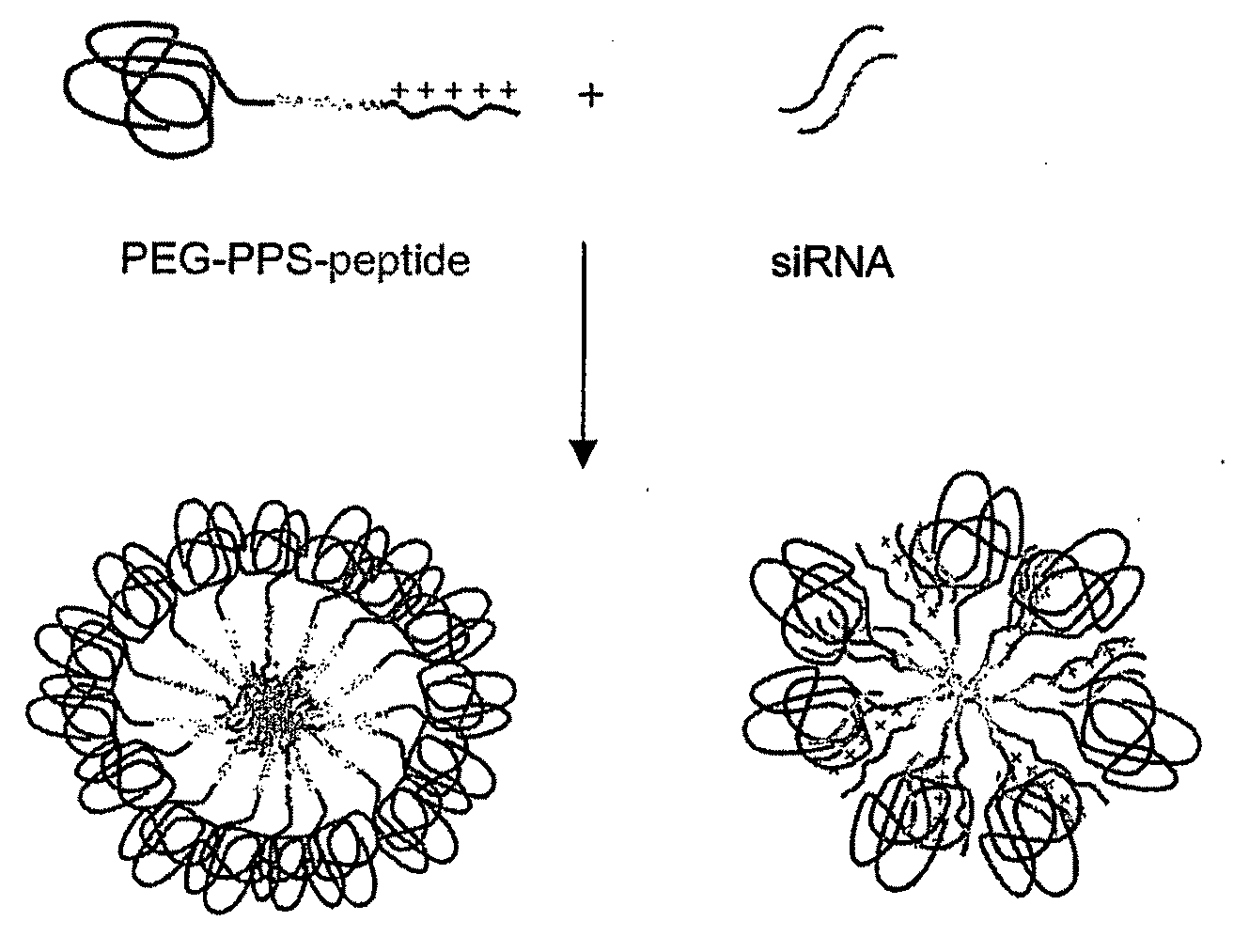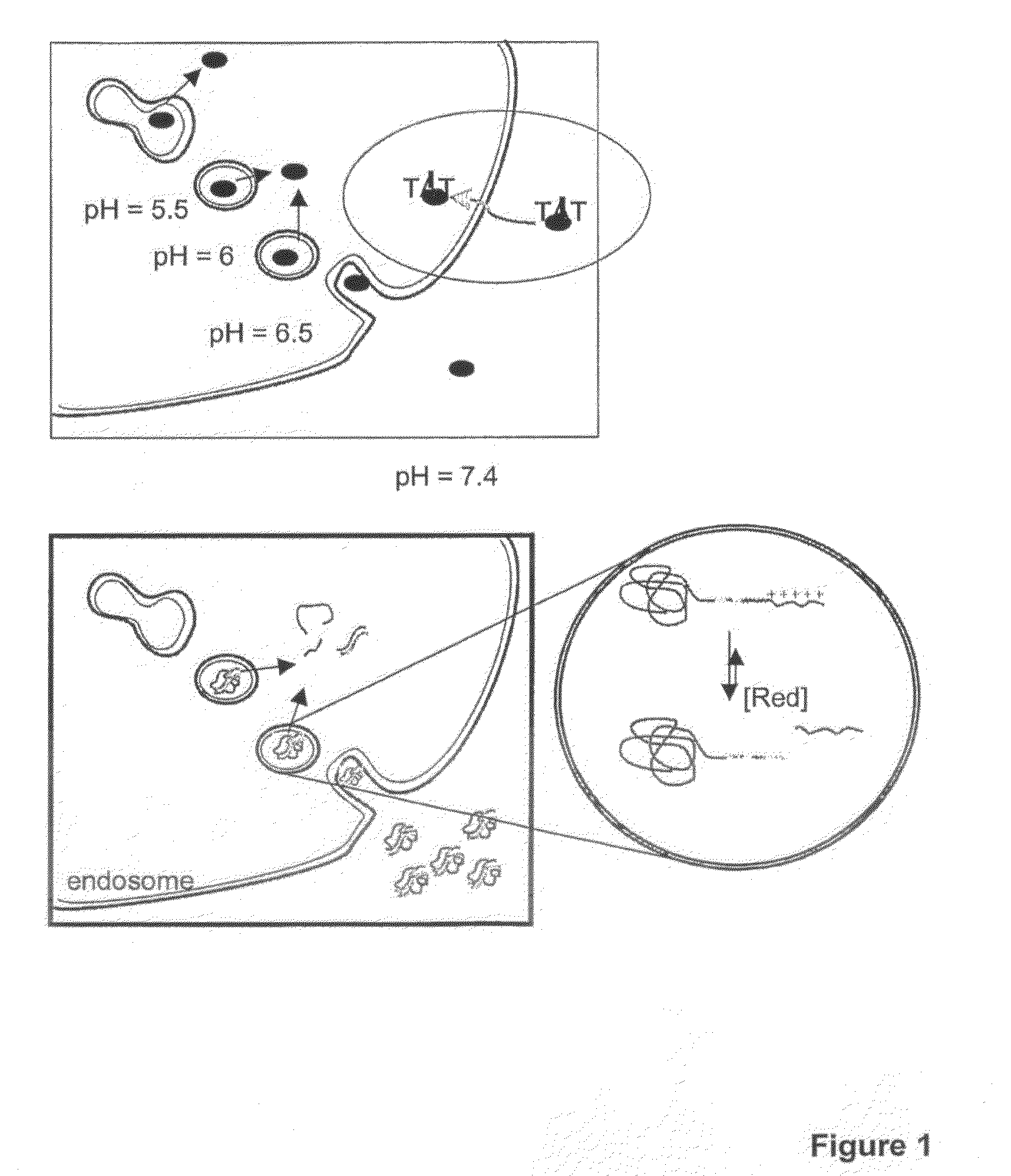[0011]In another aspect, the invention features a method for delivering a negatively charged molecule, e.g., a
nucleic acid, to a
cell including providing a triblock
copolymer, as described herein, reversibly complexed to the negatively charged molecule, e.g., a nucleic acid, and contacting the
cell with the triblock copolymer, wherein the triblock copolymer is internalized in the cell and delivers the negatively charged molecule to the cell. Once delivered, a nucleic acid, for example, reduces the expression of a
target gene in the cell or increases the expression of a gene in the cell.
[0012]The invention also features a method for treating a
disease or condition in a subject including providing a triblock copolymer, as described herein, reversibly complexed to a negatively charged molecule, e.g., a nucleic acid, and administering a therapeutically-effective amount of the triblock copolymer to the subject, wherein the triblock copolymer is internalized in a cell in the subject thereby delivering the negatively charged molecule to the cell, and treating the
disease or condition in the subject. The disease or condition treated is, for example,
cancer,
restenosis, scar formation, or postsurgical adhesions (e.g., by delivering siRNA that targets HIF-1α or PAI-1). The negatively charged molecule, e.g., nucleic acid, may reduce or increase the expression of a
protein in the cell, e.g., by decreasing expression from a target nucleic acid or by providing nucleic acid sequences capable of being expressed in the cell.
[0023]The present invention also includes
nucleobase oligomers that are chimeric compounds. “Chimeric”
nucleobase oligomers are
nucleobase oligomers, particularly oligonucleotides, that contain two or more chemically distinct regions, each made up of at least one
monomer unit, i.e., a
nucleotide in the case of an
oligonucleotide. These nucleobase oligomers typically contain at least one region where the nucleobase
oligomer is modified to confer, upon the nucleobase
oligomer, increased resistance to
nuclease degradation, increased cellular uptake, and / or increased binding affinity for the target nucleic acid. An additional region of the nucleobase
oligomer may serve as a substrate for enzymes capable of cleaving RNA:DNA or RNA:RNA hybrids. By way of example,
RNase H is a cellular
endonuclease which cleaves the RNA strand of an RNA:DNA duplex. Activation of
RNase H, therefore, results in cleavage of the RNA target, thereby greatly enhancing the efficiency of nucleobase oligomer inhibition of
gene expression. Consequently, comparable results can often be obtained with shorter nucleobase oligomers when chimeric nucleobase oligomers are used, compared to phosphorothioate deoxyoligonucleotides hybridizing to the same target region.
[0026]Arabinonucleic acids (ANAs) can also be employed in methods and reagents of the present invention. ANAs are nucleobase oligomers based on D-
arabinose sugars instead of the natural D-2′-
deoxyribose sugars. Underivatized ANA analogs have similar binding affinity for RNA as do phosphorothioates. When the
arabinose sugar is derivatized with
fluorine (2′ F-ANA), an enhancement in binding affinity results, and selective
hydrolysis of bound RNA occurs efficiently in the resulting ANA / RNA and F-ANA / RNA duplexes. These analogs can be made stable in cellular media by a
derivatization at their termini with simple L sugars. The use of ANAs in therapy is discussed, for example, in Damha et al., Nucleosides Nucleotides & Nucleic Acids 20: 429-440, 2001.
[0029]By “treating” is meant preventing or delaying an initial or subsequent occurrence of a disease or condition; increasing the disease-free survival time between the disappearance of a disease or condition and its reoccurrence; stabilizing or reducing an adverse symptom associated with a disease or condition; or inhibiting or stabilizing the progression of a disease or condition. This includes
prophylactic treatment, in which treatment before the disease or condition is established, prevents or reduces the severity or duration of the disease or condition. In another embodiment, the length of time a patient survives after being diagnosed with a disease or condition and treated using a method of the invention is at least 20, 40, 60, 80, 100, 200, or even 500% greater than (i) the average amount of time an untreated patient survives, or (ii) the average amount of time a patient treated with another therapy survives. By “treating
cancer” is meant causing a reduction in the size of a tumor, slowing or preventing an increase in the size of a tumor, increasing the disease-free survival time between the disappearance of a tumor and its reappearance, preventing an initial or subsequent occurrence of a tumor, or reducing or stabilizing an adverse symptom associated with a tumor. In one embodiment, the percent of cancerous cells surviving the treatment is at least 20, 40, 60, 80, or 100% lower than the initial number of cancerous cells, as measured using any standard
assay. Preferably, the decrease in the number of cancerous cells induced by administration of a composition of the invention is at least 2, 5, 10, 20, or 50-fold greater than the decrease in the number of non-cancerous cells. In yet another embodiment, the number of cancerous cells present after administration of a composition of the invention is at least 2, 5, 10, 20, or 50-fold lower than the number of cancerous cells present after administration of a
vehicle control. Preferably, the methods of the present invention result in a decrease of 20, 40, 60, 80, or 100% in the size of a tumor as determined using
standard methods. Preferably, the
cancer does not reappear, or reappears after at least 5, 10, 15, or 20 years. In another desirable embodiment, the length of time a patient survives after being diagnosed with cancer and treated with a composition of the invention is at least 20, 40, 60, 80, 100, 200, or even 500% greater than (i) the average amount of time an untreated patient survives or (ii) the average amount of time a patient treated with another therapy survives.
 Login to View More
Login to View More 


